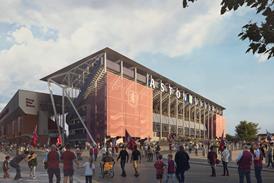Housing becomes a key election issue as Democrats focus on affordability and urban development across the U.S., writes Chris Fogarty

You may have noticed that we have a pretty important election approaching here in the United States. There are many compelling reasons for Americans to vote this November, not least the need to protect democracy and reproductive rights. However, alongside these major issues, another normally minor topic is gaining substantial attention, particularly among Democrats: housing has become a critical election issue, so much so that Kamala Harris’s first economic policy statement calls for the construction of 3 million new homes over the next four years.
Her focus on housing recognises that, just like in the UK, the high costs of renting or buying a home are significant contributors to the persistent economic unease many people feel. These costs are also keeping inflation stubbornly high, despite the overall strength of the economy. No amount of economic stimulus or interest rate cuts alone can resolve this issue—only the construction of more homes can.
In reality, any President has few specific tools other than macroeconomic policies to help housing. Housing strategy is typically determined and implemented at the state and local levels. Democratic states like New York, and particularly California, are falling significantly behind in new house building when compared to Republican states like Texas and Florida, partly because they have less red tape and fewer zoning restrictions when it comes to new construction. Coupled with the endless homeless encampments across Californian and West Coast cities, it’s hard not to feel that liberalism is really failing when it comes to housing.

No one would ever claim that New York is the easiest place to find an affordable apartment. Unlike most major U.S. cities, New York is predominantly a rental market, with 70% of its residents renting rather than owning their homes. Among these renters, over half of NYC households—nearly 1.2 million—are considered “rent-burdened,” meaning they spend at least 30% of their income on rent. Moreover, more than 30% of the city’s tenants are classified as “severely rent-burdened,” spending at least half of their income on rent. To put it another way, the average New York City renter needs an annual income of approximately $134,000—nearly double the city’s median household income—to afford an average apartment and avoid economic hardship.
So, what is preventing us from just building more homes? There are two major roadblocks. One is bureaucratic—red tape slowing approval processes and outdated zoning laws that restrict denser housing. The other is the sheer expense of building, due to high land, construction (labour and materials), and financing costs. You would think that reducing red tape and updating our zoning should be relatively straightforward, but NIMBYism and the fear among locally elected officials of losing re-election if they allow new development in their districts have effectively stalled many major rezoning initiatives for decades.
In recent years, however, Democrats have begun to recognise the importance of affordable housing for the health and viability of the entire city. Eric Adams, our flamboyant, nightclub-loving mayor, has directed the City Planning Department to rewrite all NYC zoning laws to increase the amount of residential development that can be built across the city. The “City of Yes” zoning changes range from allowing accessory dwelling units (ADUs) in the rear yards of single-family houses to substantial increases in bulk for any project that provides affordable housing at lower Area Median Income (AMI) levels, as well as eliminating parking requirements for projects near subways and train stations. Separate zoning updates will allow additional bulk for reducing buildings’ environmental impact and make it easier to convert office buildings to residential use.

Normally, a plan like “City of Yes” would be dead on arrival at City Hall, but for once, the council members seem to have an urgency to act. Separately, the city is introducing a scheme to reduce the time it takes to rezone smaller parcels of land, making it quicker and easier to build larger buildings across the city. It’s an incredibly ambitious plan, and we’ll see if it gets approved as currently set out within the next six months.
Bureaucracy and NIMBYism are only part of the problem, though. To help mitigate the cost of construction, most rental buildings across the U.S. are built with the help of Payment in Lieu of Taxes (PILOT) plans. These are state and city tax abatements for building owners that postpone property taxes on a project. The abatement typically lasts anywhere from 10 to 25 years and decreases over time. In NYC, a multi-family rental building must set aside a portion (usually 20-30%) of the units for affordable low- to moderate-income tenants to qualify for the abatements. Tenants must prove that their income falls within specified income bands, which can range from 0 to 130% of the average income for that area.
In certain zoning districts, the city may allow or mandate that developers build more deeply affordable units, incentivised by bonuses that permit them to construct taller, larger buildings. Naturally, developers also benefit from the tax abatement as well.
The NYC abatement programme, known as 421-a and now as 485-x, has run almost continuously for over 50 years and now supports the construction of approximately 10,000 apartments a year, of which 30% are considered affordable—though in reality, only 10% of those are truly affordable for lower-income tenants. To make a real dent in the housing crisis, it is estimated that the city needs to build six times this amount each year. At the current rate, we will have a shortfall of nearly 500,000 units by 2032.
The city also supports the construction of fully affordable projects where all the units are reserved for very low-income New Yorkers. Typically, for-profit developers partner with nonprofit organisations to develop housing for people who might never be able to afford to rent a decent apartment. The same tax abatements and zoning bonuses apply, but these projects benefit from extremely cheap financing provided by NYC through municipal bonds backed by the city. In this case, developers receive a healthy development fee in lieu of the risk/reward of developing market-rate units and can take pride in knowing, as one of my clients put it, they’re “doing God’s work.”
We recently completed a fully affordable apartment building called The Eliza in the low-income neighbourhood of Inwood at the northernmost tip of Manhattan. Financed by the city, it also includes a new public library, a kindergarten school, and a community centre. Immediately next door, a new market-rate building is also opening. In that building, a typical one-bedroom apartment rents for $3,300 per month. In our building, those same units rent for between $500 and $1,600, depending on your income. Applications for the affordable units are processed through the NYC Housing Lottery, and The Eliza was overwhelmed with over 80,000 applicants vying for just 173 units—a stark reminder of the demand for affordable housing in the city.
Will New York’s new zoning and streamlined organisation make a significant impact on the number of homes that get built? The early signs are promising; with the new tax abatement programme, our office is already seeing a flood of new projects and inquiries. Welcoming a new President who has made housing one of her top priorities would be an incredible way to start 2025 and can only help.
Postscript
Chris Fogarty is co-founding principal of Fogarty Finger
















No comments yet